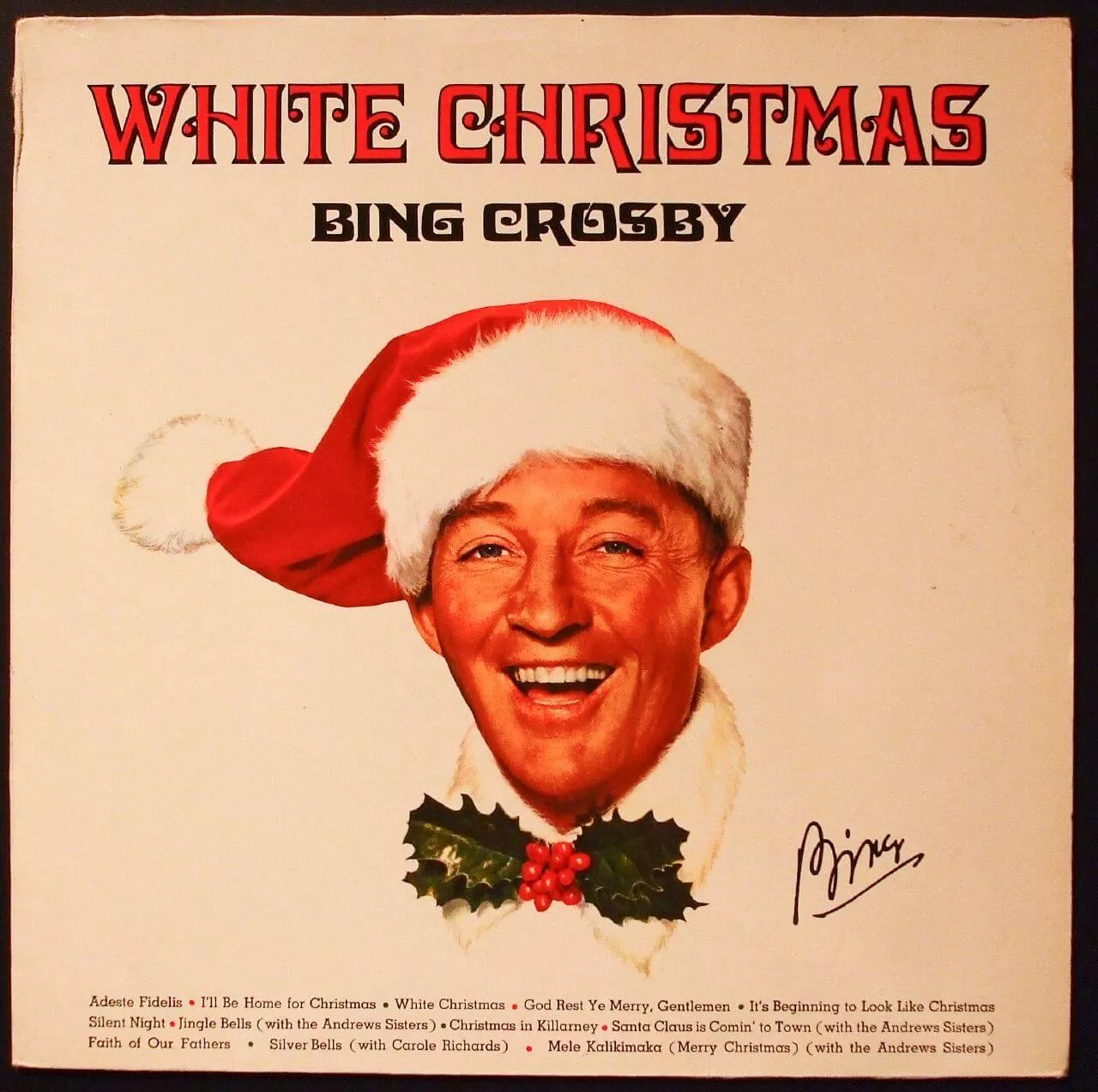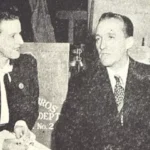As dawn's first light kissed the peaks of Mount Rainier, it cascaded down to the bustling waterfront of Tacoma, Washington, where the rhythmic hum of industry mingled with the salty tang of the Puget Sound. It was in this thriving corner of the Pacific Northwest that Harry Lillis Crosby Jr., known to the world as Bing Crosby, first opened his eyes on May 3, 1903, in a house that would one day stand in the annals of history as much more than a childhood home.
The world into which Bing was born was one of transformation and opportunity. Tacoma, a city cradled by the lush evergreens of Washington State, was not just a hub for the lumber and shipping industries, but a growing cultural melting pot. It was here, within the walls of a modest, yet lively home at 1112 North J Street, that the first notes of Crosby's storied life would be composed.
Bing's parents, Harry Lillis Crosby, a hardworking bookkeeper, and Catherine Helen (known affectionately as Kate) Harrigan, a daughter of Irish-American lineage, knew the value of diligence and the warmth of a close-knit family. The young Crosby, the fourth of seven children, was cradled in an environment where love was abundant, and the family's shared love of music seeped into the very foundations of their home.
From the outset, Tacoma was more than just a backdrop; it was an integral character in Crosby's early narrative. The city offered a smorgasbord of culture, from the theater productions at the Tacoma Theater to the echoes of ragtime and the emerging sounds of jazz that wafted from local establishments. It was a time when the air crackled with innovation and the arts were blossoming, giving a young Crosby a rich tapestry of experiences that would influence the rest of his life.
While attending Tacoma's public schools, Bing was noted not only for his academic efforts but for his magnetic personality and a voice that even in its nascent stage had a distinctive quality. His education continued at Gonzaga High School in Spokane where he was sent in 1917. But even as he honed his scholastic pursuits, it was music that truly captured Crosby's heart and imagination. From the grandeur of church choirs to the gritty allure of vaudeville acts that passed through town, every note seemed to embed itself within his being, nurturing a deep-set love for melody and rhythm.
During these formative years, young Harry, who would only later adopt the moniker ‘Bing' from a childhood nickname, was not merely a spectator of Tacoma's thriving music scene, he was a participant. At a tender age, he took a summer job as a property boy at Spokane's “Auditorium,” where he stood in the wings, absorbing the talents of seasoned performers like Al Jolson, who would leave a lasting impression on the young crooner.
These early encounters were not simply momentary diversions; they were the sparks that ignited a lifelong flame. By the age of 14, Crosby had turned his gaze toward the art of performance, sharpening his vocal abilities and developing a charm that would one day would enamor audiences around the globe.
Bing's youthful days in Tacoma, nestled in the shadow of towering firs and hemlocks, shaped not only his artistic inclinations but his character. Those who knew him spoke of a young man who carried with him the stoic work ethic of his father and the nurturing spirit of his mother. It was these attributes that would become the foundation upon which he built his future successes.
As Crosby grew older, the world around him also changed, and Tacoma began to stretch and mold itself into a city ready for the roaring twenties. Yet, even as the excitement of a new era beckoned, the indelible mark of those tranquil Tacoma days remained a touchstone for Crosby throughout his life. It was a place of unassuming beginnings, where the seeds of a legendary career were sown amidst the backdrop of an everyday American city coming into its own.
The Crosby home was a microcosm of Tacoma's broader environment—humble, inviting, and ripe with potential. Music wasn't just a pastime within its walls; it was a vital ingredient of life, much like the omnipresent timber of the region. The melodies played in the parlor would reverberate through Bing’s life, from the stages of Spokane to the glimmering lights of Hollywood.
For Bing Crosby, Tacoma was more than the city where he was born; it was the wellspring of his musical essence and the place that fostered his undying love for song. As Crosby's life unfolded and his fame grew to immense proportions, those echoes from Tacoma—the quiet nights, the stirring harmonies, and the steadfast values—would resonate in every note he sang, every character he played, and every smile he shared with the world.
Bing Crosby's Musical Beginnings – The Dawn of a Crooner
From the shadow of Tacoma's evergreens and the industrious hum of its port, Bing Crosby's journey into the heart of American music was one not merely of distance, but of transformation. The city that had cradled his childhood ambitions and had provided a symphony of influences now watched as one of its own stepped beyond its borders to etch his name into the annals of musical legend.

Bing's first foray into the world of professional music began modestly when he joined a local band called Musicaladers in 1923. This group, comprised mainly of high school students, offered the young Crosby a platform from which to refine his skills and find his voice – quite literally. The band played at dances, small gatherings, and events, carving out a niche in the local entertainment landscape of Spokane, where the Crosby family had relocated during Bing’s teenage years.
With his smooth baritone and effortless charm, Bing soon became the standout feature of the band, even as he juggled the responsibilities of college life at Gonzaga University. He may have played on the freshman baseball team, but it was apparent where his true talents lay. As Bing's confidence on stage grew, so did his aspirations.
It wasn't long before Bing, along with fellow Musicaladers alum Al Rinker, recognized the potential for something greater. The duo ventured south to California, settling in Los Angeles with dreams as expansive as the West Coast horizon. There, they formed a new ensemble with the addition of Harry Barris—the trio came to be known as The Rhythm Boys. Their style blended jazz-infused rhythms with a unique vocal harmony that caught the ear of Paul Whiteman, one of the most popular bandleaders of the day.
The collaboration with Whiteman and his orchestra became a springboard for Crosby. As part of The Rhythm Boys, he graced stages across the United States, from the grand ballrooms of New York to the glitzy venues of Hollywood. Their music resonated with the roaring twenties audiences who were hungry for innovation, and Crosby's voice began to resonate with a nation.
In the era of speakeasies and the Charleston, Crosby's vocals were a soothing counterpoint, a reminder of the heartfelt, melodious tones that one might associate with a tranquil evening in Tacoma. His distinctive timbre began to captivate listeners, whether it was on the vinyl grooves of a record or through the crackling airwaves of a radio broadcast. With each performance and recording, Crosby refined his craft, ingratiating himself into the hearts of the American public.
It was with The Rhythm Boys that Crosby's voice reached another critical juncture. In 1927, during a performance at the prestigious Tivoli Theatre in Chicago, Bing's impromptu solo performance reportedly stole the show. This moment is often regarded as the defining event that led to his solo career—it illustrated not only Crosby's undeniable talent but also the magnetic presence that could captivate an entire auditorium.
By 1928, Crosby's ascent was not simply on the horizon; it was unfolding before an audience eager for his next move. His first number one hit with Whiteman, a jazz-influenced rendition of “Ol' Man River,” laid bare the depths of his vocal range and his ability to imbue a song with emotive power. The record's success was a harbinger of the impact Crosby would have on the music industry.
When the 1930s beckoned, Bing made the decision to venture out as a solo artist. Signing with Brunswick Records and later CBS Radio, he launched into a series of hits that would become the soundtrack of an era. “Out of Nowhere” and “Just One More Chance” were not just popular songs; they were musical narratives that showcased Crosby's innate ability to convey the human experience through melody and lyric.
The transition from a young boy in Tacoma to a national musical sensation was not without its trials. However, Crosby's steadfast work ethic, ingrained from his youth, kept him grounded and focused. He understood the power of his voice, not only as an instrument but as a conduit for emotion and connection. Audiences across the country weren't just hearing another singer; they were experiencing a voice that carried with it the nostalgia of hometown dreams and the innovation of a new musical era.
Crosby's rise in the music industry thus became a tale of perseverance and an unwavering commitment to his art. As venues grew larger and the crowds swelled, it was the memory of Tacoma's nurturing environment that remained a cornerstone of his ethos. The early support he received, the first tentative steps on local stages, and the family and community that had bolstered his aspirations were ingrained in every note he sang. And it was in these notes that a star was born, one that would shine brightly across the vast canvas of American entertainment.
The Ascent to Stardom: Breaking into the Big Time
As the decade of the 1930s dawned, the U.S. was submerged in the depths of the Great Depression, yet in these challenging times, Bing Crosby's career was buoyantly ascending. The man from Tacoma had woven his melodious voice into the fabric of the era, resonating with a nation seeking comfort and distraction from its economic woes.
One of Crosby's earliest successes as a solo artist came with his enchanting delivery of “I Surrender Dear” in 1931. The single not only showcased his velvety baritone but also his ability to infuse emotional depth into each note. It swiftly became a monumental hit and was his first to dominate the charts, effectively confirming his departure from ensemble performer to a bona fide solo star.
That same year, Crosby's relationship with Brunswick Records bore the fruit of other hit records. Tunes like “Out of Nowhere” and “Just One More Chance” captivated audiences and served to further solidify his reputation. But it was the recording of the latter that truly crystallized his star power; its emotional delivery and the pure vocal talent therein cemented Crosby's place in the hearts of listeners. The record reverberated through thousands of homes, providing a soundtrack for both joy and solace during tough times.
Crosby's vocal finesse also made waves in the burgeoning medium of radio. His CBS Radio debut was met with widespread acclaim, with his show becoming a staple for American families. His smooth, affable delivery over the airwaves turned him into a household name, and he perfected the art of radio performance. Crosby understood the unique intimacy radio provided and leveraged it to form a personal connection with each listener, almost as if he were a dear friend serenading from across the living room.
In 1932, Crosby's stardom experienced yet another boost with the release of “Please.” The song, featured in his first big film, “The Big Broadcast,” brought his voice into cinemas across the country. Crosby's silver screen debut was a landmark moment that allowed him to showcase both his singing and acting chops, broadening his appeal beyond music aficionados to the moviegoing public.
Bing Crosby was now not just a voice, but a face—a personality that people felt they knew and loved. As his filmography grew, so did his influence on popular culture. In 1936, he starred in “Pennies From Heaven,” where his performance of the titular song further demonstrated his prowess as a crooner, but also as an actor capable of bringing depth and believability to his roles.
The late 1930s brought Crosby continued success with a string of films that were both critically acclaimed and commercially successful. His on-screen charisma and natural acting ability shone brightly in “Waikiki Wedding” in 1937, which featured the Academy Award-winning song “Sweet Leilani.” This period also marked the beginning of Crosby's long-standing collaboration with director Frank Capra, with whom he would work on several key projects that further enhanced his stature in Hollywood.
Crosby's affable, easygoing screen presence made him an ideal lead in romantic comedies and musicals, and his ability to transition seamlessly between singing and acting set him apart from other stars of the time. His natural talent for comedy endeared him to audiences even further, particularly when paired with his frequent co-star, Bob Hope, in the “Road to…” series. This series would become an enduring part of his film legacy, known for its light-hearted banter, adventurous plots, and the undeniable chemistry between Crosby and Hope.
Bing Crosby's rise to stardom was also marked by his innovation in recording technology. He was one of the first performers to utilize the microphone in a way that transformed the style of popular singing. Rather than project as if on stage, Crosby crooned intimately, a technique which endeared him to listeners and revolutionized vocal performance.
Crosby's influence extended to the emergence of the “crooning” style, which became synonymous with his name. This intimate style of singing, aided by the microphone, contrasted sharply with the more bombastic delivery that had been popularized in the years before amplification. His technique was imitated by many but mastered by few, and his ability to emotionally connect with the music set a new standard for performance.
Even as the United States entered World War II in the 1940s, Crosby's impact did not waver. In fact, it expanded as he dedicated himself to entertaining troops both on the radio and in person. His recording of Irving Berlin's “White Christmas” in 1941 would become an anthem for soldiers abroad and their families back home. The nostalgic longing Crosby conveyed through this simple, yet profound song provided a sense of comfort and hope during a time of global uncertainty.
The immense success of “White Christmas” cannot be overstated. It not only earned Crosby an Academy Award but also became one of the best-selling singles of all time, an accolade that still stands. This record was more than just a hit; it was an institution, one that recurred each holiday season, reminding listeners of simpler times and the warmth of home.
Crosby's success on the radio continued unabated during the war years, and he reached perhaps the pinnacle of his film career in 1944 when he starred in “Going My Way.” His role as Father Chuck O'Malley displayed his range as an actor and struck a chord with the American public. The film was a box office hit and Crosby's performance won him an Academy Award for Best Actor. The follow-up film, “The Bells of St. Mary's,” further secured his status as a Hollywood mainstay.
Throughout his career, Crosby continued to release a string of hits that underscored his diverse talents and wide appeal. From swinging jazz tunes to touching ballads, Crosby remained the quintessential voice of an era. He moved effortlessly between genres, his voice a familiar comfort regardless of the underlying style.
With each new song, film role, and radio broadcast, Bing Crosby's star shone brighter. Yet, through the accolades and the applause, he maintained the grounded, everyman charm that had endeared him to audiences from the start. For many, Crosby was not just an entertainer but a symbol of American optimism and resilience, a reminder of the power of song to unite and uplift even in the darkest of times.
The ascent of this Tacoma native to stardom had not been meteoric; it had been steady and assured. His dedication to his craft, his adaptability, and his natural talent had aligned to propel him into the hearts of millions. Crosby had begun his journey in the Pacific Northwest, but as he reached the zenith of his career, he belonged to the world.
Bing Crosby's Iconic Film Career – The Silver Screen and Beyond
Bing Crosby's venture into the realm of cinema extended his reach as an entertainer and cemented his place in the annals of Hollywood's Golden Age. It was his charismatic on-screen presence, combined with his mellifluous voice, that transformed Crosby from a singer into a cinematic icon whose influence would ripple through generations.
Following the stepping stones laid by his early film appearances, Crosby's star continued to rise as he began taking on more substantial roles in feature films. His first starring role came with “The Big Broadcast” (1932), a film that served not only as a platform for showcasing his vocal talents but also proved that his charm could carry over from radio to film. Yet, it was in 1934 that Bing Crosby would tackle a role that solidified his stature as a leading man. In “Here Is My Heart,” Crosby's performance of “June in January” won over both critics and audiences, demonstrating his ability to embody a character and captivate viewers.
Bing's career trajectory in Hollywood continued to soar throughout the 1930s, with titles like “Mississippi” (1935) and “Pennies from Heaven” (1936), the latter of which featured one of his most memorable songs. Crosby's ability to play roles that resonated with the everyday American—often portraying characters with a common touch and affable nature—helped audiences identify with him. His film persona often reflected a man who could rise through the ranks by virtue of talent and hard work, mirroring the American Dream during a time when such ideals were sorely needed.
However, it was Crosby's collaboration with Bob Hope and Dorothy Lamour in the “Road to…” series that would create one of the most enduring screen partnerships in film history. The series, which began with “Road to Singapore” in 1940, combined adventure, comedy, and music in exotic locales, with Crosby often playing the smooth singer to Hope's comic foil. Their easy banter and impromptu musical numbers not only contributed to the films' success but also influenced the buddy film genre. The “Road to…” films were a testament to Crosby's versatility and his ability to maintain box office appeal across different film genres.
The apex of Bing Crosby's film career arguably came with the release of “Going My Way” (1944), in which he starred as Father Chuck O'Malley—a young priest whose unorthodox methods rejuvenate a struggling parish. Crosby's natural warmth and likability shone through in this character, earning him an Academy Award for Best Actor. The film's success continued with its sequel, “The Bells of St. Mary's” (1945), where Crosby reprised his role alongside Ingrid Bergman. These films showcased Crosby's talent for drama and gentle humor, allowing him to step outside the musical comedy mold and reach new heights as an actor.
Yet, amidst his various roles, one film stands out in its enduring impact on American culture: “White Christmas” (1954). This film, directed by Michael Curtiz, features Crosby's most iconic performance of the title song, a melody he had introduced to the world over a decade earlier. “White Christmas” became not just a seasonal favorite but also a reminder of home and hearth, especially to those serving overseas during World War II. The film's nostalgic pull and Crosby's heartfelt rendition of the song capture the essence of the holiday season, solidifying its place as an annual tradition in homes across the United States.
The significance of “White Christmas” cannot be understated; it has achieved an almost mythic status in the canon of Christmas music. Its sentimental longing for an idealized past and its simplicity resonated deeply with audiences, encapsulating Crosby's unparalleled ability to connect with people through song. The film itself, with its tale of camaraderie and goodwill, became a template for holiday movies that followed, and the song's association with Crosby has remained unshakable.
As Crosby's film career progressed, he continued to explore new territory. He took on more dramatic roles, as seen in “The Country Girl” (1954), where he played an alcoholic actor opposite Grace Kelly. His portrayal was both nuanced and powerful, proving that his acting abilities were not confined to light-hearted fare. In the 1956 film “High Society,” a musical adaptation of “The Philadelphia Story,” Crosby starred alongside Frank Sinatra and Grace Kelly, delivering a performance that encapsulated his sophistication and showcased his enduring charm.
Crosby's impact on the film industry extended beyond his on-screen performances. He was an early adopter of pre-recording his songs for films, a practice that would become standard in the industry. This technique allowed for greater control over sound quality and the final musical product in films, paving the way for the lush, orchestrated movie musicals that would dominate in the years to come.
Bing Crosby's foray into the moving image world contributed significantly to the craft of film and the development of musical cinema. His influence as a performer can be traced in the careers of subsequent generations of actors and singers. From Frank Sinatra to Dean Martin, and even Elvis Presley, Crosby's blend of vocal talent and screen presence provided a blueprint for celebrity that fused music with film.
As a founding father of the film musical genre, Crosby's legacy is both vast and profound. His movies continue to be enjoyed by audiences, his recordings are still cherished, and his contributions to the art of film are recognized by historians and aficionados alike. Crosby's work during the Golden Age of Hollywood has left an indelible mark on the tapestry of American entertainment, and his films remain a testament to his incredible talent and timeless appeal. The boy from Tacoma had indeed become an integral part of cinematic history, with his films continuing to evoke nostalgia and warmth decades after their release.
Crosby's Legacy in Melody: Influence on Music and Film
Bing Crosby's legacy in the realm of entertainment is as multifaceted as it is enduring. His smooth baritone voice and relaxed singing style not only defined the crooning genre but also laid the foundation for future musical trends. Crosby's approach to singing, with its intimate and conversational quality, broke away from the bombastic and theatrical styles that characterized the early 20th century, influencing the subtler nuances in vocal performances that became popular in the decades that followed.
A pioneer in the use of technology, Bing Crosby played an instrumental role in revolutionizing the music industry with his innovative use of recording techniques. In the early 1940s, Crosby became one of the first performers to master the art of studio recording, taking advantage of the latest advancements in magnetic tape recording. This allowed him to pre-record his radio shows with improved sound quality, a move that not only afforded him greater flexibility in his busy schedule but also set a new industry standard. Before this innovation, most radio shows were broadcast live, with all the limitations and pressures that came with live performances.
Crosby's foresight and adoption of these recording practices extended to his music production. He was among the first to utilize the technique of overdubbing, layering his voice during the recording process to achieve a richer, more textured sound. This practice, now commonplace in the recording industry, was groundbreaking at the time and has become a critical tool for artists across all genres, allowing for more complex and creative musical arrangements.
His timeless music, with hits like “Swinging on a Star” and “Don't Fence Me In,” continues to resonate with audiences of all ages. His recordings, many of which have become standards, reveal an artist whose work transcended the era in which he lived and became woven into the fabric of American culture. Crosby's rendition of “White Christmas” remains the world's best-selling single, with estimated sales exceeding 50 million copies globally. The song's message of longing and the warmth of home during the holidays captures a universal sentiment that continues to tug at the heartstrings of listeners.
In cinema, Crosby's presence was equally influential. His relaxed acting style and natural charisma allowed him to transition seamlessly between comedy, drama, and musicals. Crosby's ability to play off his co-stars, particularly in the “Road to…” series with Bob Hope, set a high bar for on-screen chemistry and comedic timing. He also demonstrated his dramatic chops in films like “The Country Girl,” for which he received critical acclaim. His versatility in front of the camera not only made him a box office draw but also contributed to the evolution of film genres, particularly the musical.
Crosby's accolades reflect the profound impact of his work. He was awarded an Academy Award for Best Actor for his role in “Going My Way” and received multiple nominations for his subsequent films. Crosby also collected 23 gold and platinum records, a testament to his success in the recording industry. In 1962, Crosby was awarded the Grammy Lifetime Achievement Award, and posthumously, he was inducted into the Grammy Hall of Fame, securing his legacy in the annals of music history.
What truly underscores Crosby's continuing relevance is how modern entertainers still draw inspiration from his work. The casual ease with which he performed, paired with his impeccable timing and phrasing, has influenced generations of singers from Frank Sinatra to Michael Bublé. His film performances have been studied and emulated by actors who seek to capture the same naturalistic style that Crosby seemed to effortlessly possess. His approach to celebrity—a combination of talent, charm, and a down-to-earth demeanor—has become the benchmark for those in the limelight.
Despite the passage of time, Bing Crosby remains a central figure in the narrative of American entertainment. The technological advances he championed continue to benefit artists and audiences alike. His music, with its timeless quality and emotional resonance, continues to be discovered and cherished by new generations. Crosby's cinematic legacy, through memorable films and performances, remains a touchstone for both nostalgia and the enduring appeal of classic Hollywood. His achievements, recognized through numerous awards and accolades, reflect an artist whose work not only defined an era but also transcended it, ensuring that Bing Crosby's influence will be felt for years to come.
As we transition to the more personal facets of Crosby's life, it is evident that his public triumphs were mirrored by a complex private existence, marked by both challenges and personal victories.
The Man Behind the Melody: Crosby's Personal Life
Harry Lillis Crosby, known to the world as Bing, was not only a master of melody but also a man of complex character and profound personal depth. Away from the glitter of Hollywood and the resonance of his recorded voice, Crosby's personal life was filled with both enchanting harmonies and occasionally dissonant chords. Born into a working-class family in Tacoma, Washington, the fourth of seven children, Bing's early life was underscored by the values of camaraderie and hard work.
Bing's father, Harry Lillis Crosby Sr., worked as a bookkeeper, and his mother, Catherine Helen (known as Kate), was a second-generation Irish-American who dedicated her life to raising their large family. Despite the modesty of their living conditions, Kate ensured that music and warmth filled their home. It was this nurturing environment that sowed the seeds of Crosby's own values and priorities, ones that would later echo through his life.
Though he would become one of the world's most celebrated figures, Crosby's personal interests often harked back to the simple pleasures of his youth. An avid sportsman, he found solace in golf, fishing, and hunting, hobbies that afforded him a connection to nature and a respite from his demanding career. His love for golf was legendary, as Crosby would host the Bing Crosby Pro-Am, known today as the AT&T Pebble Beach Pro-Am, combining his charitable interests with his passion for the sport.
Family was the cornerstone of Crosby's personal universe. His first marriage to singer and actress Dixie Lee in 1930, bore four sons: Gary, twins Phillip and Dennis, and Lindsay. Crosby's fatherly role, however, was marked with complexities and contrasts. A disciplinarian, his parenting style often reflected the stern approach of his era, and his time away for work led to strained relationships with his sons. However, his dedication to his family was evident in his determination to provide for them, a reflection of the values instilled by his own parents.
Tragedy was not absent from Crosby's life, with the premature passing of Dixie Lee due to ovarian cancer in 1952. The loss of his partner was a profound blow, casting a shadow that lingered long after. Despite this personal heartache, Crosby found love again and remarried Kathryn Grant in 1957, with whom he had three children: Harry, Mary Frances, and Nathaniel. His relationship with Kathryn and his younger children was often seen as more tender and involved, perhaps a testament to his evolving perspective on life and fatherhood.
Crosby's personal challenges were not confined to his private relationships. He grappled with the pitfalls of stardom, navigating a public image that sometimes felt at odds with his private self. Despite his warm public persona, those close to Crosby knew of his quiet, introspective side, one that cherished privacy and deep contemplation. Crosby's journey with spirituality was a personal endeavor, influenced by his Catholic upbringing and his own quest for meaning.
The pressures of fame also brought Crosby into a tumultuous relationship with alcohol. While he was able to maintain his professional obligations, his drinking sometimes impacted his personal life, an issue that he wrestled with throughout much of his adulthood. Yet Crosby's resilience and ability to face these personal challenges contributed to the profound authenticity that his fans sensed, even if they could not fully know its origin.
Even with the spectrum of trials and triumphs, Crosby remained deeply connected to his roots. His bond with Tacoma and the state of Washington remained robust, and he would often reference his Pacific Northwest upbringing with a sense of pride and nostalgia. The small, timber-rich city where he was born had left an indelible mark on his identity, shaping the man he became.
Crosby's personal narrative is an intricate tapestry woven from threads of joy, sorrow, triumph, and trial. Through the persona of “Bing,” the public glimpsed a man of charm and light-heartedness, yet beneath lay a deeper complexity. His life offstage was an anthology of the roles he played: a son of Tacoma, a loving partner and father, a golfer, a fisherman, and a seeker of solitude. Each role played its part, composing the symphony of his life—a melody distinctly human in its range and resonance.
As we look at Crosby's impact beyond his immediate circle, his philanthropic endeavors reveal yet another dimension of his character. Crosby's generosity and commitment to giving back were as integral to his legacy as his velvet voice and cinematic charm. In the next section, we will explore Crosby's charitable work and how it reflected his dedication to using his influence for the greater good, cementing his role not only as an entertainer but also as a benefactor to the community that shaped him.
Giving Back: Crosby's Philanthropic Efforts
Bing Crosby, renowned for his mellifluous voice and cinematic charisma, also held a deep-seated commitment to philanthropy. His charitable efforts were expansive, covering a wide range of causes and organizations, and leaving an impact that reverberated far beyond his stardom. Crosby's giving spirit was as much a part of his identity as his legendary performances, and it reflected his desire to support the communities that had supported him throughout his career.
One of the most significant beneficiaries of Crosby's generosity was his alma mater, Gonzaga University in Spokane, Washington. His bond with the institution was not only one of personal nostalgia, having spent part of his higher education there, but also of ongoing support. He frequently raised funds for the university, and his contributions were instrumental in the development of its library and the Crosby Student Center. The center housed memorabilia from his career, served as a gathering place for students, and symbolized Crosby's dedication to fostering educational opportunities for future generations.
Education was a recurrent theme in Crosby's philanthropic endeavors. Understanding the importance of nurturing young minds, Crosby also lent his support to the creation of the Bing Crosby Youth Foundation. The foundation focused on providing scholarships and educational resources to children and young adults. Crosby's passion for education underscored his belief that every individual deserved a chance to learn and excel, irrespective of their background.
Crosby's charitable nature also extended to healthcare, a cause close to his heart following his first wife Dixie Lee's battle with ovarian cancer. His empathy for those facing medical challenges led him to work closely with various medical organizations, including the American Cancer Society. Crosby would often lend his voice to their campaigns, raising awareness and funds for cancer research and patient care. His fundraising efforts were particularly impactful during the Christmas season, where he used his iconic rendition of “White Christmas” to inspire giving and spread hope.
Beyond healthcare and education, Crosby's philanthropic reach touched numerous other causes. He was known for his contributions to disaster relief efforts, supporting communities that were devastated by natural calamities. Crosby's response to such crises was swift and significant, reflecting a global sense of responsibility that transcended his own immediate community.
In Tacoma, Crosby's birthplace, his legacy of kindness is perhaps most palpable. Crosby never forgot his roots, and his contributions to the city were aimed at enriching the cultural and social landscape of the community. He helped finance the construction of the Tacoma Little Theatre, fostering a love for the arts in a city that had given him so much. The theater became a hub for artistic expression, echoing Crosby's own journey from the stages of Tacoma to the bright lights of Hollywood.
Moreover, Crosby was instrumental in establishing the Crosby Boys' Club in Tacoma. This initiative provided a safe space for young boys to engage in sports, arts, and educational activities, helping to keep them off the streets and offering them the mentorship Crosby valued in his own youth. The club served as a testament to Crosby's commitment to giving back to his hometown and investing in its future leaders.
Another demonstration of Crosby's profound influence on his hometown was the Bing Crosby Holiday Show. This annual event was more than a seasonal festivity; it brought together the Tacoma community and raised funds for local charities. Crosby would often donate his performance fees to various Tacoma-based organizations, ensuring that his success was shared with those who needed it most.
Crosby's charitable legacy also had a national scope. He was known for his contributions to the United Service Organizations (USO), bringing entertainment and a touch of home to American troops serving abroad during World War II. His dedication to the USO revealed Crosby's patriotic spirit and his gratitude to the men and women in uniform.
In the world of golf, his philanthropy found another avenue for expression. The Bing Crosby Pro-Am, also known as the Crosby Clambake, became not only a showcase of his love for the sport but also a charity event. Proceeds from the tournament were distributed to a variety of charitable causes, including youth organizations and educational scholarships, reflecting Crosby's wish to blend his interests with his commitment to philanthropy.
Throughout his life, Bing Crosby's contributions to charitable causes were driven by a genuine desire to make a positive difference. He used his platform to advocate for those in need and to spark change through his generous spirit. Crosby's philanthropy was as integral to his legacy as his artistic achievements, and it is a facet of his life that continues to inspire admiration and respect.
Crosby's efforts to uplift and support various communities were not done for accolades or recognition but stemmed from a heartfelt connection to humanity and a wish to use his success for the greater good. This deep-seated benevolence is an intrinsic part of the Crosby story, blending seamlessly with the nostalgic memories of his iconic voice and the cinematic moments that he crafted.
As we reflect on Crosby's life and the breadth of his charitable work, it is clear that his impact on the world was not confined to entertainment alone. Crosby's philanthropic footprint has left an enduring mark on the communities he held dear, particularly his beloved Tacoma, which cherished him as much as he cherished it. His philanthropy is a melody of compassion that played in perfect harmony with his life's work, and it continues to echo through the initiatives he supported and the lives he touched.
Tacoma Remembers: Honoring Crosby's Hometown Legacy
In the tapestry of Tacoma's history, Bing Crosby remains one of the most cherished threads, his legacy woven into the very fabric of the city. The love affair between Crosby and his hometown of Tacoma, Washington is ongoing, with the city consistently finding heartfelt ways to honor its beloved son who, despite his global fame, never lost touch with his roots.
Tacoma has enshrined Crosby's memory in various ways, ensuring that the generations to come will not forget the local boy who crooned his way into America's heart. The most prominent of these is Gonzaga University's Crosby House, which has been transformed into a museum dedicated to his life and career. Once Bing’s childhood home, it now resides on the campus grounds and serves as a pilgrimage site for his fans. It houses a comprehensive collection of Crosby memorabilia, including gold records, photographs, and personal items, each telling the story of his journey from Tacoma to the pinnacle of world entertainment.
Moreover, Bing Crosby's music and films remain interlaced with the cultural fabric of Tacoma. Annual tributes and film screenings are commonly held, particularly around the holiday season when “White Christmas” seems to emerge from every corner of the city, a comforting and familiar refrain that is synonymous with Yuletide cheer. These events are communal affairs, reflecting Crosby's ability to bring people together in both celebration and reflection.
One such event is the Bing Crosby Holiday Film Festival, which is held in Spokane but draws many from Tacoma, eager to revel in the nostalgia of Crosby's classic films. Here, fans can indulge in a marathon of Crosby's cinematic achievements, reaffirming his status not just as a superstar, but also as a hometown hero who made the world his stage.
In Tacoma itself, the annual lighting of the Christmas tree in the Broadway Plaza is accompanied by Crosby's rendition of “White Christmas,” reminding Tacomanians of Crosby’s undying presence in the city. This tradition infuses the holiday spirit with a sense of history and local pride, as the song has become an anthem that transcends generations and continues to evoke a warm sense of communal nostalgia.
The city also pays homage to Crosby through the Bing Crosby Theater, a testament to his enduring influence in the realms of music and film. Here, his performances are regularly showcased, allowing visitors to step back in time and experience the magic that Bing brought to the stage and screen. The theater is not just a venue for entertainment; it is a space that encapsulates Crosby's passion for the arts, and his belief in their power to inspire and unite communities.
Furthermore, Gonzaga University, where Crosby spent part of his collegiate years, has named a student center in his honor. The Crosby Student Center is a hub of activity, embodying Crosby's spirit of camaraderie and his dedication to education. The presence of the center on campus serves as a daily reminder of his legacy and the philanthropic spirit he so generously shared with his alma mater.
Tacoma has also recognized Bing Crosby in more subtle and permanent ways. There is a plaque placed in his honor at the Tacoma Performing Arts Center, an acknowledgment of his significant contributions to the arts and his unbreakable bond with the city. This quiet tribute speaks volumes of Crosby’s importance to Tacoma, representing a steadfast memory of the city's gratitude for its most famous son.
In addition to these memorials and events, Crosby's impact on Tacoma is felt in the community programs that continue to thrive because of his philanthropic work. While these initiatives may not carry his name, they are part of his legacy of care and support for the city he loved. Crosby's spirit of giving continues to motivate and guide charitable works in the city, ensuring that his commitment to helping others lives on.
Tacoma's pride in Bing Crosby is as unwavering as it is profound. The city not only celebrates his achievements but also embodies the values he represented: compassion, humility, and a boundless love for his community. While the legendary crooner may have left us in physical form, his voice continues to resonate through the streets and hearts of Tacoma. His legacy is cherished, safeguarded, and shared, and Tacoma continues to embrace Bing Crosby not just as a star of yesteryear, but as an ever-present source of local pride and inspiration.
Tacoma's ongoing affection for Crosby is a powerful testament to the deep bond between a community and one of its most illustrious sons. It is an affection that has not diminished with time but rather has grown stronger, a nostalgic yet lively homage to a man who remains, for many, the beating heart of this Pacific Northwest city. With each passing year, the resonance of Crosby's legacy in Tacoma only becomes more profound, ensuring that his voice, his philanthropy, and his connection to the city will continue to be celebrated for generations to come.

Lifelong bacon junkie. Lifelong internet fanatic. Hipster-friendly travel aficionado. Twitter lover. Avid food buff. Incurable travel trailblazer.













